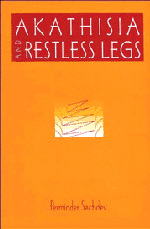Book contents
- Frontmatter
- Contents
- Foreword
- Acknowledgements
- Abbreviations
- Part I Introduction
- Part II Drug-induced akathisia
- Part III Restless legs syndrome
- Part IV Conclusions
- Appendix A Haskovec's Akathisie
- Appendix B Prince Henry Hospital Akathisia Scale
- Appendix C Barnes (1989) Akathisia Rating Scale
- Appendix D Hillside Akathisia Scale (version 4)
- References
- Index
Appendix C - Barnes (1989) Akathisia Rating Scale
Published online by Cambridge University Press: 12 September 2009
- Frontmatter
- Contents
- Foreword
- Acknowledgements
- Abbreviations
- Part I Introduction
- Part II Drug-induced akathisia
- Part III Restless legs syndrome
- Part IV Conclusions
- Appendix A Haskovec's Akathisie
- Appendix B Prince Henry Hospital Akathisia Scale
- Appendix C Barnes (1989) Akathisia Rating Scale
- Appendix D Hillside Akathisia Scale (version 4)
- References
- Index
Summary
Patients should be observed while they are seated and then standing while engaged in neutral conversation (for a minimum of 2 minutes in each position). Symptoms observed in other situations, eg, while the patient is engaged in activity on the ward, may also be rated. Subsequently, the subjective phenomena should be elicited by direct questioning.
Objective
0 = Normal, occasional fidgety movements of the limbs
1 = Presence of characteristic restless movements; shuffling or tramping movements of the legs/feet, or swinging of one leg, while sitting, and/or rocking from foot to foot or ‘walking on the spot’ when standing, but movements present for less than half the time observed
2 = Observed phenomena, as described in 1, which are present for at least half the time observed
3 = Patient constantly engaged in characteristic restless movements and/or unable to remain seated or standing without walking or pacing, during the time observed
Subjective
Awareness of restlessness
0 = Absence of inner restlessness
1 = Nonspecific sense of inner restlessness
2 = Awareness of an inability to keep the legs still, or a desire to move the legs, and/or a complaint of inner restlessness aggravated specifically by being required to stand still
3 = Awareness of an intense compulsion to move most of the time and/or report of a strong desire to walk or pace most of the time
- Type
- Chapter
- Information
- Akathisia and Restless Legs , pp. 363 - 365Publisher: Cambridge University PressPrint publication year: 1995



